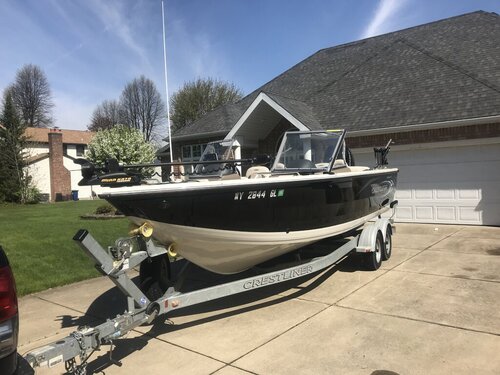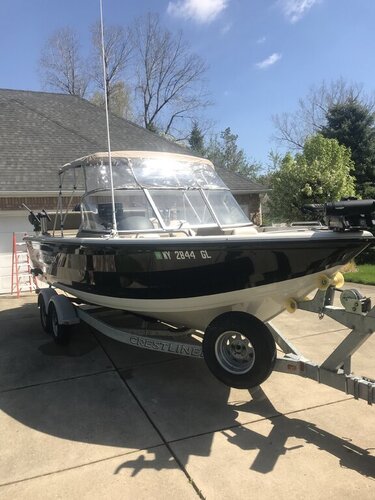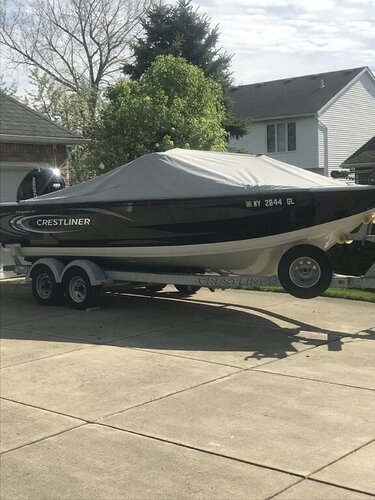-
Posts
80 -
Joined
-
Last visited
Content Type
Profiles
Forums
Events
Gallery
Store
Posts posted by smallboat
-
-
2013 Crestliner Sportfish 2150 SST with 250 HP Mercury Verado w/DTS and smart gauges; 2014 Shorelander galvanized trailer w/brakes and spare tire; Less than 270 hours on motor. Boat in very good condition. Minn Kota Terova 80 w/i-pilot link; Garmin Echo Map 93SV; Humminbird 858 HD DI; VHF radio; Raw water wash down; Cannon Digi Troll II downriggers; Cisco tracks, vinyl decks; snap in carpet; Bimini top w/ side and aft curtains; additional custom canvas plus mooring cover; 3 battery chargers - 2 AC, 1-Minn Kota alternator; 2 AGM house batteries, 2 Deep cycle trolling batteries; aerated live well. This is an outstanding big lake boat.
.thumb.jpg.9a31f2175ca2adb247e1ed37c40524c5.jpg)

.thumb.jpg.d8fc2708027a35f52d685a6676df9aa7.jpg)


Sent from my iPhone using Lake Ontario United mobile app -
Is your deep cycle battery also your starting battery, or do you have a separate starting battery?
-
Any 10# available?
-
Youngstown is a nice launch, used it several times. Only problem parking. No parking for a rig near it.
-
x2. Its the only good way to mount on the transom.
-
I thought the state wide limit is 5 for walleye. Am I wrong?
-
L&M is correct, formerly made by Borg Warner, now Regal Beloit. Google Velvet Drive transmissions and you will find them.
-
You are probably referring to Velvet Drive transmissions. They are a major supplier of transmissions for marine applications as well as industrial. It is a brand name and does not describe any particular function or type. They are high quality and were very commonly paired with big block gas engines. They are still in business and located in South Carolina.
-
I have installed several of these through the years and they are not all the same. Many of the cheaper ones use cheap castings for holding the filter and thy don't always mate well with the filter. Cheap ones will sometimes use clamps on the hoses. Marine grade units typically have crimped high pressure hoses and a machined filter holder. You cant walk home if the hose lets loose out on the water. Regardless of which type you buy, be aware it may use a different filter than you currently have on the engine.
-
Typical of a "green" agenda. Never consider the facts involving an issue, simply create a narrative that suits your point of view and label every other perspective as ignorant or worse.
Seen this too many times confronting well meaning people on different issues who just simply don't have, or choose to ignore, the correct information.
-
NYS has changed its advisories for eating fish from all waters around the state. If you have concerns about eating Ontario fish, check out the new publication.
-
Haven't fished the Canadian side yet this year but if you run east to the Niagara bar, the lake trout have been really strong along with a pick of cohos.
-
I have also found that a number of NOAA website addresses that I have saved don't work anymore. All of the information is still available but you have to look for the new addresses.
I found wave height and wind speed at: http://www.glerl.noaa.gov/res/glcfs/
Hope this helps.
-
Two sets of Michigan bronze Dyna Jet Props.
One set 17" X 18" X 1.375" tapered shaft, RH & LH $250/set
One set 18" X 18" X 1.375" tapered shaft, RH & LH $250/set
Both sets in good condition.
Local pick up, no shipping.
-
Hard to tell much from the picture but here are a couple of suggestions. It appears you may have multiple coats of paint on the bottom if that is blue paint showing through the black in the picture. If also appears the paint has peeled away from the hull just below the boot stripe and left a bare spot. If both or either of these are true, you need to remove the paint that is on the boat for good results. Having the boat soda blasted is far easier and better than trying to sand the paint off.
If the paint on the boat is an ablative paint and the picture is only showing stains, you can power wash the hull and repaint with an ablative paint. You cannot put a hard bottom paint over an ablative paint, it will not stay on. you can cover a hard bottom paint with an ablative paint if the hard paint is in good condition and you power wash the bottom first.
Cost for painting a bottom varies by the yard but figure they will charge you for the paint plus 2 to 3 hours of labor at the yard rate. Some yards will charge you a flat rate of $XX per foot based on the boat,s LOA.
-
Did you check Fishing Hotspots website? If its not listed, try calling them. They are very helpful when you call.
-
I have a PDF for the Digi Troll 2 owners manual. Send me your e-mail and I will send you a copy.
-
-
The color of each wire in a boat's electrical system indicates its function. All boat manufacturers follow ABYC guidelines for color coding wires so, assuming this wire is original to the boat, the green color indicates grounding or bonding. Green is not used for any other purpose in marine 12 or 24 volt systems. All marine electricians should know this.
-
The green wire you are referring to is a grounding wire for the fuel fill. It is there to prevent a spark when you put the nozzle from the pump into the fill pipe. This wire is NOT part of your electric system but should be wired DIRECTLY to the negative bus bar or negative post of your starting battery with a minimum 14 ga. green wire.
On a larger inboard boat, this wire would be part of the boat's bonding system and wired into that system.
-
Thanks for the info. I'll post what we find if I get out..
-
Just curious, did you launch at the fort or Lewiston? I am going to try later this week. When I checked the ramps at the fort last week, there was a lot of debris blocking the south ramp.
-
I have poured foam into several boats I have restored. Your decision was correct to use 2lb closed cell foam. It won't absorb water the way open cell or 1lb foam will. Its a messy job but straight forward. US Composites in Florida also sells 2lb foam kits and they are usually quite competitive in price. Their website can be very informative.
-
Everyone here has stated excellent points but I thought I would through my two cents in. No one has mentioned the fact that what ever battery type you choose for the Terrova, it should be a deep cycle and not a starting battery (obvious I know). I run two series 29 deep cycle on my Terrova pulling a 22' boat and they last 5 to 6 hours on a charge when trolling.
As far as AGM batteries go, they are excellent and will take a lot of abuse but they are expensive. They will survive deeper discharges and frequent charging. They also require a different charge rate so if you have an older charger you need to check it for compatibility. I had a bank of them on my previous boat as house batteries. They ran a 2000 watt inverter in addition to everything else and you could not kill them even after 9 years.
Did you also know that Mercury states in their owners manual that they will void the warrantee on a Verado for electrical issues if you use a wet cell battery as a starting battery? They require an AGM starting battery.



2013 Crestliner Sportfish 2150 SST $41,500
in Boats for Sale
Posted
I’d like to see the boat. Send pm
Sent from my iPhone using Lake Ontario United mobile app